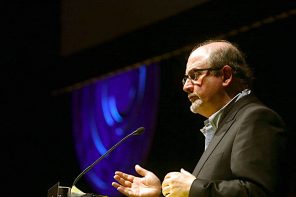Last week, when Wiccan priestess Deborah Maynard delivered the opening prayer for the Iowa House of representatives the leader of the Covenant of Unitarian Universalist Pagans (CUUPS) in Cedar Rapids became just the third Pagan priestess to offer such a prayer before a state body. Some members of the Iowa house boycotted her prayer by arriving late, and Rep. Rob Taylor (R-West Des Moines) actually turned his back to Maynard claiming it was a form of peaceful protest in response to a practice he perceived as spiritually evil.
This incident occurred almost one year after the Town of Greece v. Galloway decision in which the Supreme Court ruled that “sectarian” prayers before government meetings are constitutional, so long as no one is coerced to participate and the government doesn’t deliberately exclude representatives of other faiths from taking their turn to offer the prayer.
In a dissenting opinion, Elena Kagan argued that sectarian prayers are inappropriate in contexts such as town hall meetings where religious minorities may be petitioning the government for help. But she prefaced her dissent by explaining: “I believe that pluralism and inclusion in a town hall can satisfy the constitutional requirement of neutrality; such a forum need not become a religion-free zone.”
Rep. Taylor’s response to last week’s prayer shows why inclusion is not a simple solution. When minority religions give opening prayers, there have been retaliations from the majority in the form of political protests and—in some cases—vandalism and death threats. So the promise of rotating in prayers by minority faiths is less viable in practice than on paper. At worst, the language of pluralism in these contexts becomes a fig leaf that allows the religious majority to circumvent the Establishment Clause. According to RadioIowa, Dave Heaton (R-Mount Pleasant), a Christian, said “If we want to make a stink about who can do this and who can’t, we’re liable to lose the whole thing.” The “whole thing” in this case refers to opening prayers that are sectarian and predominately Christian.
But there’s a deeper problem. Since Maynard “just wanted to show that the House is very inclusive of all faith traditions,” and Taylor regards Wicca as evil and destructive, one of these religious commitments will have to be disregarded. At stake in the response to Maynard’s prayer is a theoretical problem about what religious pluralism is and ought to be. How can you include faiths that do not value inclusion? And if you exclude these faiths, how can you claim to be inclusive? This is the paradox of pluralism.
Religion scholars have presented different theories of pluralism and pointed out different obstacles in approaching it. Diana Eck gives a three-fold theory of religious pluralism:
1) Pluralism is not just diversity because it requires active participation and an “attunement to the life and energies of one another.”
2) Pluralism is not just tolerance because it involves an active attempt to understand each other.
3) Pluralism is not just relativism because it entails, “engagement with, not abdication of, differences and particularities.”
Stephen Prothero has warned of the dangers of “pretend pluralism,” in which we don’t sincerely understand the religious other because we pay attention only to those religious values and differences that are pleasing while ignoring commitments we find controversial or distasteful. Prothero writes, “We need to understand religious people as they are—not just at their best but also their worst. We need to look at not only their awe-inspiring architecture and gentle mystics but also their bigots and suicide bombers.”
This is where pluralism gets tough. For Taylor and like-minded Christians, opposition to Maynard’s religion, and a refusal to engage with it on its own terms, is a religious commitment. Taylor explained:
I prayed about this a lot the last several days and I thought to myself: ‘What would Jesus do?’ Jesus would be in the chamber, from my perspective. He would passively protest and then he would seek that individual out, have a peaceful conversation with them about why his way was the best way, so that’s what I did today.
Other Christians conspicuously engaged in “counter-prayer” during Maynard’s invocation. Some cited the “powers and principalities” referenced in Ephesians and claimed that Maynard’s prayer was casting a demonic influence over the Iowa representatives. Pastor Michael Demastus explained, via RadioIowa:
“I was praying that she [Maynard] would come to know the one true God. I believe that the occult is dark. I do believe that’s not the place to seek guidance from, so I was not praying against her. I was praying against what she was doing.”
We can argue that these intolerant views are not “real” religious values, but this would be to engage in pretend pluralism. If we just dismiss Taylor’s opposition to Maynard then we are not engaging with his particularities seriously.
Russell McCutcheon concludes that the kind of pluralism described by Eck, while well intentioned, is impossible. He suggests that pluralism comes with “undisclosed ground rules” that exclude certain religious commitments: “The only way to have such co-existing differences is if the other is already well on the way to playing one’s own game, making the leftover, minor differences something you can easily put up with.” In other words, pluralism is very inclusive of religious traditions who already play well together, but exclusive toward those that do not.
As McCutcheon points out, there is a danger that when we understand ourselves to be promoting pluralism, we are enforcing a tacit division between “good” and “bad” religions (what Leonard Primiano called a “two-tiered model of religion”). A recent example is the fracas that occurred last year when The Satanic Temple offered to re-enact a black mass as part of a Harvard cultural studies club. The Temple’s multicultural performance was quickly reinterpreted as “hate speech” and the event was cancelled. While Harvard prides itself on being diverse and inclusive, the Temple ran afoul of the undisclosed ground rules and was denied a place in the cultural studies club.
Maynard encountered a problem similar to that of the Harvard cultural studies club. She crafted her prayer to “show respect to all faiths,” even invoking God before any other forces or personages, apparently to welcome her Christian critics. But how can a pluralist show respect to faiths that reject the project of pluralism?
The Canadian Supreme Court ruled this week that no public prayers can be held before city council meetings. In that court’s view, even non-sectarian prayers violate the principle of neutrality because they favor belief over non-belief. Here in the United States, it seems premature to conclude that Elena Kagan is wrong and that government meetings must become religion-free zones. One can imagine an uneasy détente in which representatives are conspicuously absent whenever they disagree with the sectarian prayer being given that day. This situation would be constitutional according to Greece v. Galloway, but it would also turn daily meetings into one more battlefield in the culture war.
It’s even possible that if Taylor actually did have a “peaceful conversation” with Maynard about their respective faiths (as he suggested Jesus would have done) some sort of mutual understanding could be reached. Either way, this case starkly reveals that pluralism is not a simple undertaking. Anyone can achieve pluralism with well-meaning and like-minded people of different faiths. But finding a harmonious relationship with exclusivists requires more than just “being nice.”



